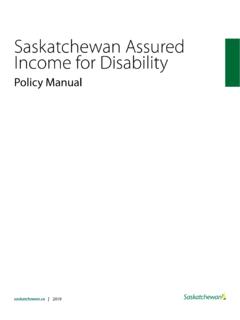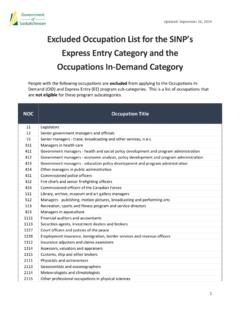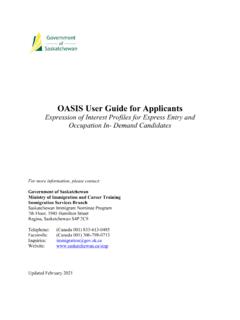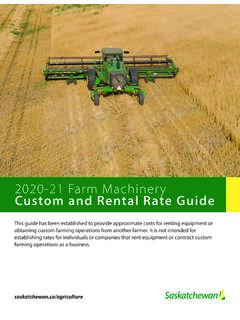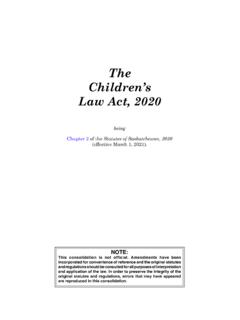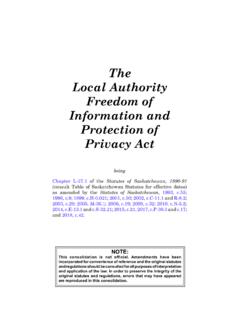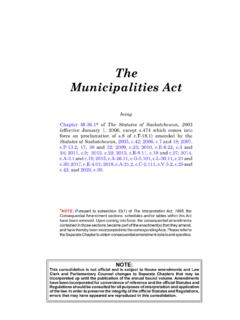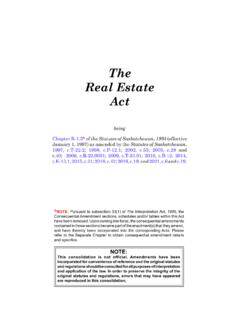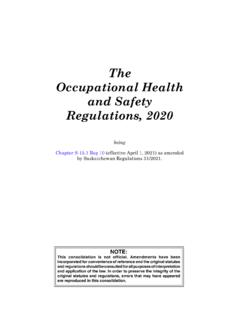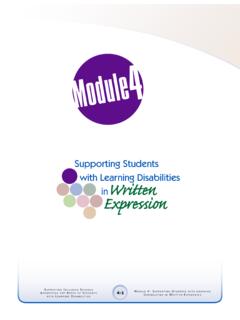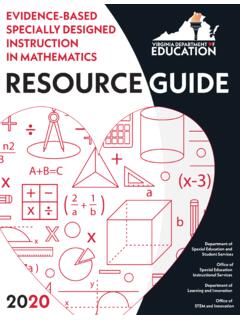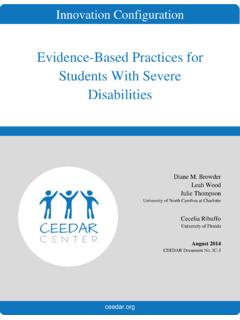Transcription of Reading Development and Instruction Students with Reading ...
1 Teaching Students with ReadingDifficulties andDisabilitiesA Guide for EducatorsIntroductionUnderstanding learning disabilities Reading Developmentand InstructionWritten ExpressionInstructionAssessment andInterventionGeneral TeachingConsiderationsTransition PlanningSelf-AdvocacyAppendicesReference sSaskatchewanLearning2004 ISBN 1-894743-79-2 Teaching Students with Reading Difficulties and disabilities :A Guide for Educators3 ContentsTABLEOFCONTENTS1. Understanding learning Definition .. of learning disabilities .. of learning disabilities .. Strengths .. Areas Associated with learning disabilities ..193. Reading Development and Elements in Reading Instruction ..35 Reading Comprehension ..36 Language Cues and Conventions ..37 Phonological Awareness and the Graphophonic Cueing System ..38 Phonics.
2 38 Vocabulary Development and the Semantic Cueing System ..39 Sentence Patterns and the Syntactical Cueing System ..40 Text Forms, Features, and the Textual Cueing System ..40 Author s Intent and the Pragmatic Cueing System ..40 Reading Fluency ..424. Written Expression .. Skills ..535. Assessment and and Program Planning ..576. General Teaching Adaptive Dimension .. and Effective Practices ..70 Teaching Students with Reading Difficulties and disabilities :A Guide for Educators4 Contents7. Transition Principles of Effective Transitions .. Effective Transitions ..858. to Self-Advocacy .. Self-Advocacy ..919. AppendicesAppendix A Strategies and Resources for Assessing and Teaching Reading B Strategies and Resources for Assessing and Teaching Phonemic C Phonics ..127 Appendix D Vocabulary Development .
3 139 Appendix E Reading Fluency ..145 Appendix F Spelling ..159 Appendix G Written Expression ..163 Appendix H Personal Program I Transition J Assistive Technology ..21510. de ressources pour l immersion ..237 Teaching Students with Reading Difficulties and disabilities :A Guide for Educators5 ContentsACKNOWLEDGEMENTSS askatchewan learning extends thanks to contributing writers of this document: Lynne Wawryk-Epp, Dr. Gina Harrison, and Dr. Bill Prentice. Appreciation is also extended to the members of the Reference Committee:Marilyn AllenCoordinator of Student Services St. Paul s RCSSD #20 Kristina Bakken-ChriestSecondary Classroom TeacherGreenall SchoolBarb ElliottSpeech-Language PathologistSaskatoon School Division #13 Susan EngelResource TeacherSt. Agnes SchoolMoose Jaw RCSSD #22 Tammy FergusonSenior Program Manager Special Education UnitSaskatchewan LearningDorothy Finlayson (chair)Senior Program ManagerSpecial Education UnitSaskatchewan LearningGarnett Francis Assistant Professor Department of Educational Psychology & Special EducationUniversity of SaskatchewanJudy Froese Special Education CoordinatorMoose Jaw School Division #1 Laurie GarceaFinancial ManagerLearning disabilities Association of SaskatchewanJanie G n reuxFrench Language Arts CoordinatorOfficial Minority Language OfficeSaskatchewan LearningDr.
4 Gina HarrisonAssistant Professor Department of Educational Psychology & Special EducationUniversity of SaskatchewanWanda LyonsDirectorSpecial Education UnitSaskatchewan LearningDr. John McNamaraAssistant Professor Department of Educational Psychology & Special EducationUniversity of SaskatchewanDr. Bill PrenticeEnglish Language Arts ConsultantCurriculum & InstructionSaskatchewan LearningDale RempelExecutive DirectorLearning disabilities Association of SaskatchewanRandeah RobertsonParent AdvocatePresident, learning disabilities Association of SaskatchewanJane Thurgood SagalExecutive DirectorCurriculum & InstructionSaskatchewan LearningTeaching Students with Reading Difficulties and disabilities :A Guide for Educators7 IntroductionThe purpose of this resource is to assist educators in teachingstudents who are experiencing significant difficulties, or who havea disability in Reading and written expression.
5 The documentprovides a general description of learning disabilities with a focuson the most common type of disability Reading disability (Kibby &Hynd, 2001). The terms Reading disability, Reading disorder, anddyslexiaare used interchangeably in the literature. For the purposesof this document, the term Reading disabilitywill be used. Proficient Reading and writing skills are critical to success. Ifstudents are not competent readers, they are at risk for academic,behavioural, social and emotional difficulties. Students withlearning disabilities have the potential to be successfulacademically and socially. Teachers can change the trajectory forchildren at risk for failure in Reading by intervening early andproviding explicit, intensive, and extensive Instruction . Theexpectation is that Students are taught listening, speaking, Reading ,writing, viewing, and representing skills throughout their schoolcareers.
6 When Students continue to struggle with the acquisition ofproficient literacy skills, appropriate adaptations need to be made toenable them to successfully meet the demands of the is dependent on educational programming that is suited tothe student s individual strengths, needs, and learningcharacteristics. This resource provides information on assessment, Instruction , assistive technology, transition planning, and self-advocacy for Students with Reading and written expressiondifficulties and disabilities . Information is based on current researchand effective practices in the education of Students with readingdisabilities. The suggested strategies build on SaskatchewanLearning curricula and supporting Teachingreading toadolescents is bothrewarding andfrustrating; it s a scienceand an art. It s makingmistakes andgrowing fromthem.
7 It s themost importantthing I do as ateacher. (Beers,2003, p. 22)Teaching Students with Reading Difficulties and disabilities :A Guide for Educators9 Chapter Definition of learning disabilities Reading Disability Written Expression Disorder Mathematics Disorder Nonverbal learning Neurobiological Differences Genetic Factors Other Risk Factors of learning disabilities Difficulties Associated with a Diagnosis Parent Areas Associated with learning disabilities Receptive and Expressive Language Skills Auditory/Phonological Processing Visual Processing Visual-Motor Processing Attention Memory Metacognition Study and Organizational Skills Social Skills UNDERSTANDINGLEARNINGDISABILITIEST eaching Students with Reading Difficulties and disabilities :A Guide for Educators10 Chapter 2 learning disabilities refer to a number of disorders, which may affect the acquisition, organization, retention,understanding, or use of verbal or nonverbal information.
8 These disorders affect learning in individuals whootherwise demonstrate at least average abilities essential for thinking and/or reasoning. As such, learning disabilitiesare distinct from global intellectual deficiency. learning disabilities result from impairments in one or more processes related to perceiving, thinking, remembering,or learning . These include, but are not limited to language processing, phonological processing, visual spatialprocessing, processing speed, memory and attention, and executive functions ( , planning and decision making). learning disabilities range in severity and may interfere with the acquisition and use of one or more of the following: oral language ( , listening, speaking, understanding); Reading ( , decoding, phonetic knowledge, word recognition, comprehension); written language ( , spelling and written expression); and mathematics ( , computation, problem solving).
9 learning disabilities may also involve difficulties with organizational skill, social perception, social interaction, andperspective taking. learning disabilities are lifelong. The way in which they are expressed may vary over an individual s lifetime,depending on the interaction between the demands of the environment and the individual s strengths and disabilities are suggested by unexpected academic under-achievement or achievement which is maintainedonly by unusually high levels of effort and support. learning disabilities are due to genetic and/or neurobiological factors or injury that alter brain functioning in amanner which affect one or more processes related to learning . These disorders are not due primarily to hearingand/or vision problems, socio-economic factors, cultural or linguistic differences, lack of motivation, or ineffectiveteaching, although these factors may further complicate the challenges faced by individuals with learning disabilities may co-exist with various conditions including attentional, behavioural and emotionaldisorders, sensory impairments, or other medical success, individuals with learning disabilities require early identification and timely specialized assessments andinterventions involving home, school, community, and workplace settings.
10 The interventions need to be appropriatefor each individual s learning disability subtype and, at a minimum, include the provision of: specific skill Instruction ; accommodations; compensatory strategies; and self-advocacy UNDERSTANDINGLEARNINGDISABILITIESThe hallmark characteristic of a learning disability is an individual s academic underachievementin Reading , writing, and/or mathematics despite the presence of average to above averageintelligence, appropriate Instruction , regular school attendance, and favourable environmentalfactors. The learning disabilities Association of Canada (LDAC) provides a national definition oflearning disabilities (see Figure ).Figure Official National Definition of learning DisabilitiesFrom Official Definition of learning disabilities by learning disabilities Association of Canada, 2002.
